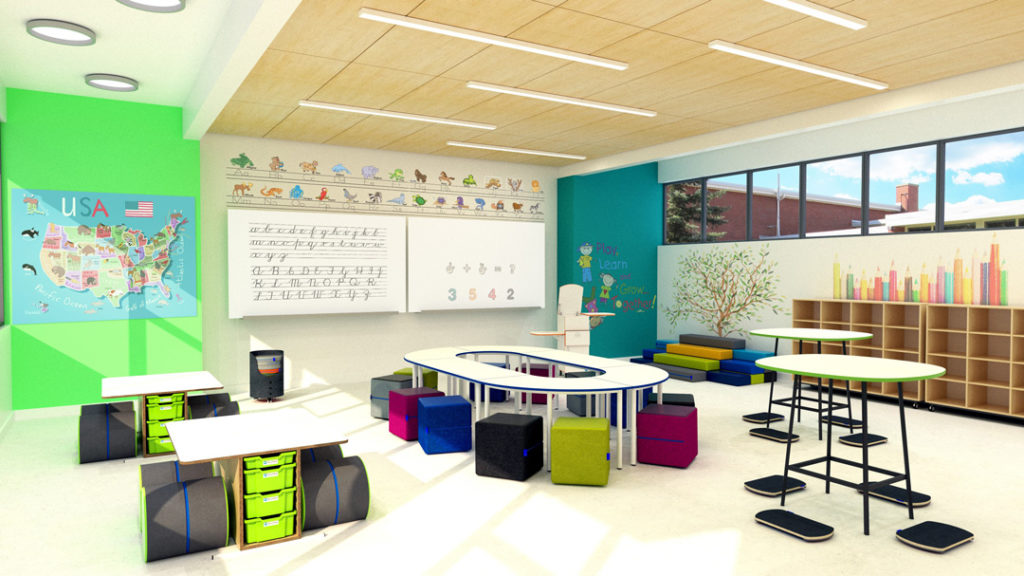At NorvaNivel, all the learning spaces we create are designed to empower learners. We recognize that spaces are not one-size-fits-all, but need to cater to learners’ profiles. Having surfaces at varied heights with options to sit or stand ensures learners feel comfortable in their space at any time and provides a sense of ownership over their space.
With learning environments being shared by multiple grade levels and teachers, and for different purposes, many educators are considering height-adjustable desks and chairs. Yet there are several reasons why varying height seating and desk options might offer a more inclusive and engaging learning environment. Let’s look at some of the considerations for choosing height-adjustable in your learning environment.
TIME FOR LEARNING
In theory, height-adjustable seems like the ultimate solution. If the space is being shared, older learners keep a higher height, and younger learners take a shorter height. Our team of Education Consultants, who collaborate with schools and are all former educators themselves, have seen that this is not always the case. At NorvaNivel, we design for the 60 Second Rule: our spaces can be rearranged by students for any learning activity in under sixty seconds. Having height-adjustable pieces can create questions such as: Who is in-charge of adjusting the height? Is the height is only adjusted based on the grade of the learners in the space? Adjusting the height can become a burden to the teachers, takes time away from instruction, and if the height-adjustable mechanism breaks, the table doesn’t function as needed anymore. If not planned for properly, height-adjustable can lead to the space becoming stagnant when it is meant to be dynamic.
LEARNER DISTRACTION AND CONTROL
For the learner who struggles with self-regulation, a height-adjustable piece of furniture can serve as a significant distraction. As there are few height-adjustable pieces that lock, learners can spend more time adjusting the height than focusing on the lesson or task. If height-adjustable is for a collaborative table, this distraction can lead to all the learners at the table being off task. Also, if there’s one gregarious learner who decides that she’d like to stand while the other learners want to sit, this leads to a loss in voice and choice and control. Now only one learner is controlling the fate of the other learners at the table. Height-adjustable is ideal for individual desks to ensure agency and voice and choice.
UDL AND AGENCY
Fischetti’s research concludes that, “learning spaces are also a question of equity. What works for one child won’t necessarily work for another. One might prefer working at a traditional desk while another will feel more comfortable on the floor” (2016). Learner agency is essential in the future-ready learning environment. Just because a learner is older does not mean that she needs a higher seating option. Some learners prefer to stand during lessons while others prefer to sit up high or cross-legged on the floor. Understanding learners’ learning profiles and multiple intelligences assists with providing the correct seating option. For the different subjects and activities, the height may matter. A learner may struggle in math and need to be seated with her feet on the floor and a proper sitting height table; but during English, which is her best subject, she may be more comfortable with the content and can therefore sit on the floor with a lap desk. Universal Design for Learning (UDL) provides research and tools to support the fact that all learners do not learn the same, and need different ways to access their learning. Providing varying height pieces ensures learners are empowered to choose the place that best works for them during the learning activity. This ownership of the space and voice and choice provides learner agency, and this leads to success and less behavioral issues.
INTENTION AND PURPOSE
As with anything else, be intentional with your learning space design. There is a time and a place for height-adjustable, but it’s not the only solution. By taking Interest Inventories of your learners at the beginning of the year, you can easily determine how they prefer to learn during particular subjects. A varied-height learning environment allows learners control of their environment and working in a space that works for them.
At NorvaNivel, we provide learning environments that cater to the needs of the vast array of learners you teach. A varied-height learning environment provides a space that is inclusive, dynamic, and empowers learners to have ownership of their learning and space. It encourages the space to continue to adapt to learner engagement and control, and to learners being empowered through agency.

